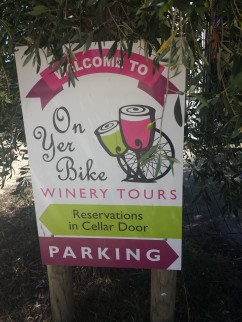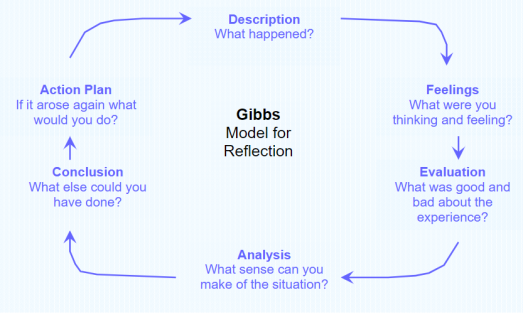
Peddling around vineyards on a hot summer’s day in our beautiful Hawkes Bay got me thinking. What is it about online social networks (let’s drop the clumsy wording and just use “online social”) that could help someone like me develop professionally, or contribute to another colleague’s professional development?
An interesting question, because right up until now (2018) online social has been used by me nearly exclusively to keep my students engaged in the course. Reflecting on my use for professional development, though, I see now that I use online social just like a menu – surfing the internet for little interesting snippets and tips, tasting the occasional article to see if it could “work”, and looking at a wide range of sources from industry experts (are they experts, really?) to educator sources.
A very simple model of reflection in action was offered by Gibbs (1988; in Finlay, 2008), to help practitioners understand the links between theory and practice; that is, that both enrich the other.

However, looking more closely at this model, I can’t easily see how to apply the cycle to the use of online social for either my professional development, or to contribute to others. I can see how to use the model in terms of the student’s professional development, but that’s off topic.
If we consider the Google+ community as part of online social, then it is easy to see how school teachers are using and benefiting from the collaboration opportunities. This has not really been replicated with my university peers, certainly not in my work setting. So, I have been reflecting about business teaching academics and our seeming reluctance to get involved in professional development on the topics of teaching. Innovating Pedagogy (2016) provides a suite of ideas about incorporating online social to benefit teachers and learners. A key point that stuck with me for online social to work well is the use of a facilitator, who keeps people engaged and contributing. Another key point is to include experts so learners can discuss, check out their understandings and receive advice. Lastly, and quite significantly, managing such online social sites takes long-term commitment and enthusiasm from a facilitator and contributor/s.
So, where is this post going?
Starting with Gibb’s model (let’s make it work), what happened was that resistance to online social as a practical way to engage students and teaching academics surfaced early in my department. Comments that starting and managing a Facebook page (for example) would take far too much time that should be given to research were commonplace. In my area, I am the only lecturer who runs Facebook pages and a Twitter account to help the students engage with the course materials. The model asks for “thinking and feeling”; at the time I was very disappointed, and very surprised too – we teach marketing…which is hyper-digitized. I thought that alone would encourage people to use online social for teaching and learning. What was good and bad about the experience? Students responded positively and appropriately. Some colleagues ignored the opportunity to use online social to learn, and to communicate. The sense I make of the situation is that there are too many competing priorities for teaching academics, resulting in teaching and learning taking last place. This includes creating and participating in initiatives designed to help professional practice, and to move into using more contemporary pedagogical tools.
In sum: I could have worked harder to get buy-in. I could have demonstrated how using online social works very well with students and for our own professional development (although I have no real evidence for the latter). An action plan for the future is: provide the research that shows that online social is a must-use, almost mandatory now for marketing teaching academics, both for our students and for ourselves. I have academic articles I can use to back up this assertion, and six years of practical use of online social in a university business school to share.
References.
Finlay, L. (2008). Reflecting on “Reflective practice”. PBPL Paper 52; The Open University.
Sharples, M., de Roock, R., Ferguson, R., Gaved, M., Herodotu, C., Koh, E., Kukulska- Hulme, A., Looi, C-K., McAndrew, P., Rienties, B., Weller, M., & Wong, L.H. (2016). Innovating Pedagogy. Exploring new forms of teaching, learning, and assessment, to guide educators and policy makers. Open University, Innovation Report 5.